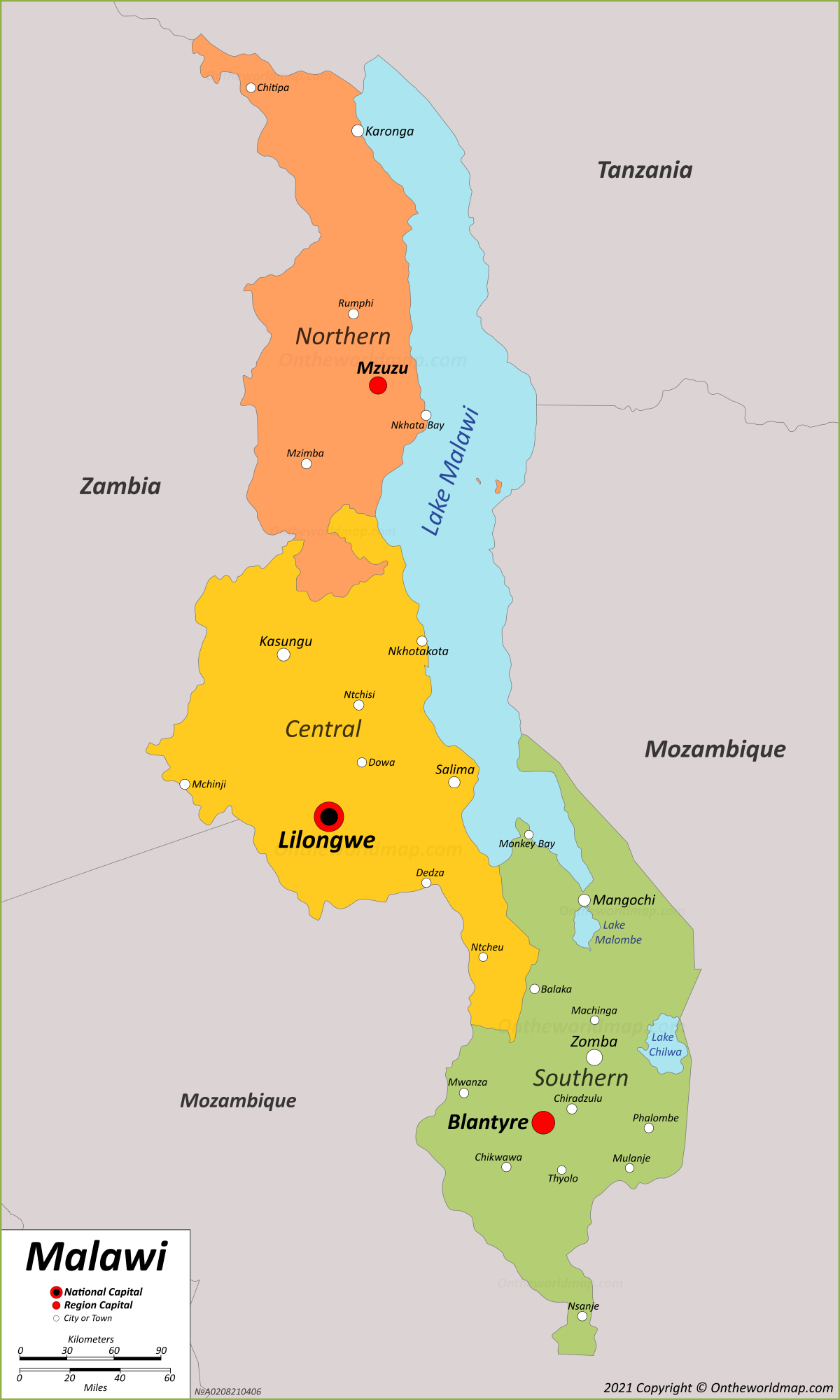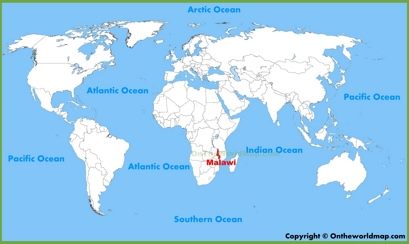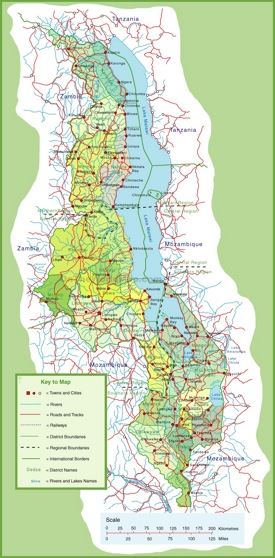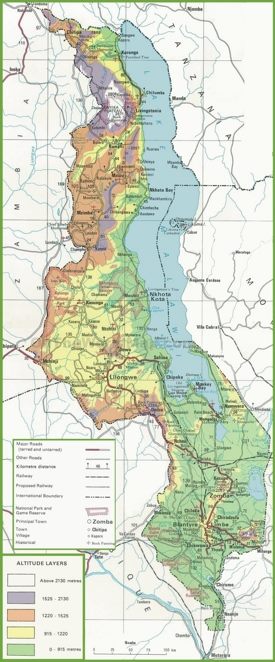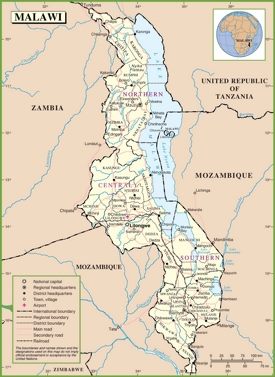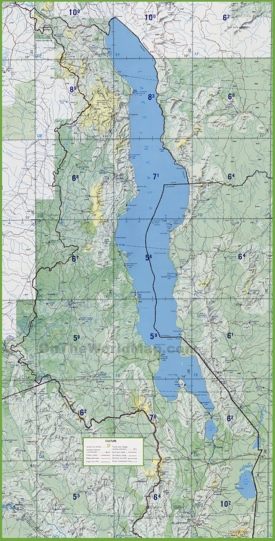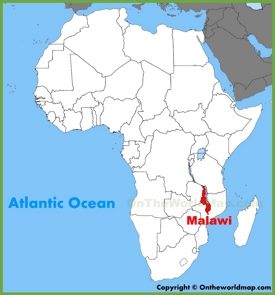Malawi Map
Description:
This map shows governmental boundaries of countries; lakes, regions, region capital cities, major cities and towns in Malawi.
Size: 1200x2000px / 369 Kb
Author: Ontheworldmap.com
You may download, print or use the above map for educational, personal and non-commercial purposes. Attribution is required. For any website, blog, scientific research or e-book, you must place a hyperlink (to this page) with an attribution next to the image used.
Online Map of Malawi
Detailed Maps of Malawi
About Malawi
Malawi, a landlocked country in southeastern Africa, is bordered by Tanzania to the north, Mozambique to the east, south, and southwest, and Zambia to the northwest.
Lilongwe, the capital and largest city, serves as the political and administrative center. Other major cities are Blantyre, a commercial center, and Mzuzu, an important center for agriculture and trade in the northern region.
Malawi's economy is largely based on agriculture, with tobacco, tea, and sugar as its main exports. The agricultural sector employs a large proportion of the population and contributes significantly to GDP. Efforts to diversify the economy include the development of the mining sector, with a focus on uranium and rare earth minerals, and the development of tourism.
Malawi faces challenges such as poverty, limited infrastructure and dependence on rain-fed agriculture, which makes the economy vulnerable to climate variability. The government and international partners are working on initiatives to improve infrastructure, education and health to promote economic development and reduce poverty.
Lake Malawi, one of the largest lakes in Africa, offers fishing and tourism opportunities that boost the local economy. The country's biodiversity and natural beauty attracts tourists, which supports efforts to develop sustainable tourism as a means of economic growth.
The Facts:| Capital: | Lilongwe |
| Area: | 45,747 sq mi (118,484 sq km) |
| Population: | ~ 21,200,000 |
| Official language: | English |
| Currency: | Malawian kwacha (D) (MWK) |
| Driving side: | left |
| Calling code: | +265 |
| Internet TLD: | .mw |
| Time zone: | UTC+2 (CAT) |
| Gross domestic product 2023 (PPP): |
|
| Gross domestic product 2023 (nominal): |
|
Largest Cities: Lilongwe, Blantyre, Mzuzu, Zomba, Kasungu, Mangochi, Karonga, Salima, Nkhotakota, Liwonde, Nsanje, Rumphi, Mzimba, Balaka, Mchinji, Mulanje.
Regions of Malawi: Central, Northern, Southern.
Districts of Malawi: Dedza, Dowa, Kasungu, Lilongwe, Mchinji, Nkhotakhota, Ntcheu, Ntchisi, Salima, Chitipa, Karonga, Likoma, Mzimba, Nkhata Bay, Rumphi, Balaka, Blantyre, Chikhwawa, Chiradzulu, Machinga, Mangochi, Mulanje, Mwanza, Nsanje, Thyolo, Phalombe, Zomba, Neno.
Geography of Malawi
Malawi, located in southeastern Africa, is characterized by a diverse geography including highlands, plateaus, and the Great Rift Valley. Lake Malawi stretches along the country's eastern border and influences the local climate and ecosystem. The Shire Highlands in the south and the Nyika Plateau in the north are characterized by varied topography and altitudes.
Malawi has a tropical climate with distinct wet and dry seasons. The wet season lasts from November to April, characterized by heavy rainfall and higher humidity, while the dry season lasts from May to October, characterized by lower temperatures and reduced rainfall. Regional climatic variations are due to differences in elevation and proximity to Lake Malawi. This climatic diversity supports a variety of agricultural activities and contributes to the country's rich biodiversity.
Brief History of Malawi
Malawi's history reflects a rich interplay of indigenous cultures and colonial influence. Bantu-speaking peoples settled in the region around the 10th century, establishing various kingdoms and societies. In the late 19th century, British explorers, including David Livingstone, arrived here, leading to increased European interest. In 1891, the British established the protectorate of Nyasaland, incorporating the region into their colonial empire.
Malawi gained independence from British rule in 1964, with Hastings Kamuzu Banda as its first president. Banda's regime, initially one-party, lasted until 1994, when Malawi transitioned to a multi-party democracy. Since then, the country has experienced peaceful political change and continues to address challenges such as economic development and poverty reduction. Malawi's historical path defines its national identity and development trajectory.

